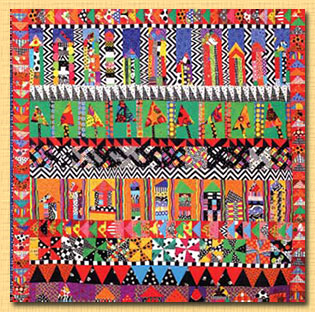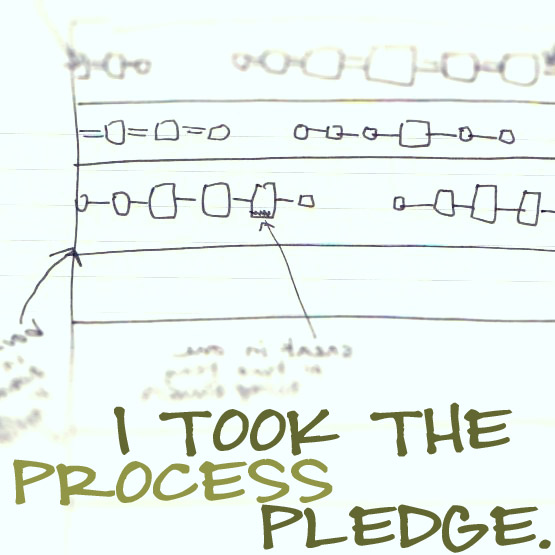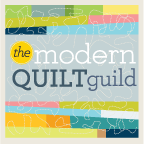Wise to the exigencies of medical practices, and while waiting for the endodontist to finish with an emergency patient, I quietly pulled my bag of handwork out and began hand quilting a small, colourful block in bright, heavy threads. When the doctor finally arrived, he looked at my lovely folk art block and said, bemused "Hmmm. We had a lady here who used to make those...those...blanket things!".
Indeed. I do make "those blanket things". A lot of us do!
Consider the following scenario in an email from quilter Betsy:
"Do you remember the fundraiser auction for Zach's [her son] elementary school? And how we consulted on fabric and colour choices that would be likely to have broad appeal and be sure to ignite a bidding war? Well, the auction went off last night and guess who bought the quilt? Me! The bidding stopped at $45, and as the auctioneer called, "going twice...", I jumped in and bid $60. Donny [her husband] thought I was crazy until I whispered to him that the quilt cost me $80 in materials alone, and it took at least 12 hours to make (it was a strip design, so went together quickly). Fairly valued, even with my time at rock bottom minimum wage, it probably cost $225 to make before factoring in the cost of my machines, tools and training, or a profit margin. I would rather gift it to someone who appreciates it and consider my $60 bid a donation to the Zach's kindergarten class. He raised his eyebrows at that but was even more surprised when three of the moms from the school approached me later and asked if I did custom work...they loved the lap quilt and really wanted one of their own, but in colours to match their decor. When I explained to them I would be happy to make them lap quilts, but handmade quilts like these, depending on the complexity of the design and quilting would start at $300. The moms were totally surprised, and a bit miffed too. They just did not believe a quilt could cost that much to make, and thought I might be padding the quote. One actually said (fingering my lap quilt) "my mom just gives these away". Donny turned to me after and said "wow, were they pissed!". I was angry too, and hurt. Nobody understands the value of what we make."
I have had similar experiences, and in my pre-quilter life was guilty of similar trespasses. In an age when you can get a "bed in a bag" from a big box store for $49.99, no one understands what actually goes into a hand made quilt. Even those people who say, and I hear it a lot, "oh! I sure wish you'd make me a quilt!". Quilts are undervalued in our culture.
This fact was brought home to me when friends at a camping trip noticed the lap quilt I had brought along for chilly evenings. They all oohed and ahhed, and then somebody said, "we'll just call you Martha from now on!". As in Martha Stewart. Which is code in hen-peck for "frumpy and funny". And when asked about doing one for each of them, I gave a quote like Betsy's, and was met with a similar level of astonishment...and hostility.
Why hostility, I wondered?
I have certainly encountered the pioneer myth...that quilters are saintly creatures who, toiling by lantern light, make transcendent quilts out of the treasured scraps left over from worn out family garments. Evidently Mother loves her family so much that even the clan rags are as silks to her! The domestic goddess' time is considered free, the materials certainly free, and the work is valued accordingly.
And part of the explanation seems to be that in a post-feminist revolution world, many women are themselves uncomfortable with the traditional domestic arts and pursuits. They have worked so hard to be seen as more than mothers and housekeepers, they avoid doing anything that might consign them back into those categories. Quilting and sewing, in their minds, let the side down. That makes for a disconnect: they love quilts, but denigrate what it takes to make them. It is an uncomfortable...and sad...reality. It is the unexamined life.
And we are all under considerable pressure to be something "uber". It is not enough to be "just" a person, you need to be a superstar in your own life, which itself is an unending, engineered stream of Hallmark Moments. It is important to impress others, to be awesome in every sense of that word. It goes beyond healthy ambition, into some shadowy need to be "more than", to be a celebrity, to be recognized as first, best and always. And it often strikes me that there is considerable pressure now to justify your tenure on this earth. You must be a warrior...for peace, or for the environment, making a contribution so huge and momentous it will get you into the Sundance film festival, the UN General Assembly, and the Sports Hall of Fame... preferably all three! The quotidian is just not good enough. This life, served straight up, is not good enough.
The quilter, quietly busy with fabric and threads, stitching her dreams and experiences into "one of those blanket things", is creating and contributing on an entirely different level.
So, how to value that quilt?
Here is what quilting is to me. I began quilting as a young adult, in the days of cardboard templates and hand sewing. I loved the colours and textures, the contemplative nature of the slow but beautiful workmanship, the delight of tackling the learning curve, and that ineffable link to times and peoples past. When the babies came along, I put that all away...it was hard to keep the little ones out of the dangerous bits like pins and needles, and I had no space or time to shop for materials and sit and make things anyway. Once they were all grown, I returned to quilting, now revolutionized by modern tools and techniques. Quilting is now faster, fresher...
...and outrageously, deliciously, artistic.
I have been quilting, more or less seriously, for about 4 years, and only now do I feel comfortably in control of my tools and materials. As a noob quilter, I would look at beautiful quilted works and get that uncomfortable feeling that I could never do anything "like that". Now I look at those same works and think "oooh, I can take that concept and take it somewhere!". My hard work at improving my skills and craftsmanship mean that I am inspired, not intimidated.
And inspired I am. Not just by the gorgeousness of colour and design, but by the zen healing of taking time and space (and money) out for myself, for my creation station time. In my middle fifties, I have arrived at middle age, and have begun to experience the myriad gains that were the focus of my younger self (education, marriage, children, home and travel), as well as the myriad losses that frame my older self (death of loved ones, illness, children becoming independent adults, aging). I realize now more than ever that I am here for a good time, not a long time. Certainly not the forever it felt like when I was 21.
Creation is proof and comfort against the gathering shadows. Something enduring, something that distills the joy I have been blessed with in this life.
Indeed. I do make "those blanket things". A lot of us do!
 |
| The auction quilt pattern... |
Consider the following scenario in an email from quilter Betsy:
"Do you remember the fundraiser auction for Zach's [her son] elementary school? And how we consulted on fabric and colour choices that would be likely to have broad appeal and be sure to ignite a bidding war? Well, the auction went off last night and guess who bought the quilt? Me! The bidding stopped at $45, and as the auctioneer called, "going twice...", I jumped in and bid $60. Donny [her husband] thought I was crazy until I whispered to him that the quilt cost me $80 in materials alone, and it took at least 12 hours to make (it was a strip design, so went together quickly). Fairly valued, even with my time at rock bottom minimum wage, it probably cost $225 to make before factoring in the cost of my machines, tools and training, or a profit margin. I would rather gift it to someone who appreciates it and consider my $60 bid a donation to the Zach's kindergarten class. He raised his eyebrows at that but was even more surprised when three of the moms from the school approached me later and asked if I did custom work...they loved the lap quilt and really wanted one of their own, but in colours to match their decor. When I explained to them I would be happy to make them lap quilts, but handmade quilts like these, depending on the complexity of the design and quilting would start at $300. The moms were totally surprised, and a bit miffed too. They just did not believe a quilt could cost that much to make, and thought I might be padding the quote. One actually said (fingering my lap quilt) "my mom just gives these away". Donny turned to me after and said "wow, were they pissed!". I was angry too, and hurt. Nobody understands the value of what we make."
I have had similar experiences, and in my pre-quilter life was guilty of similar trespasses. In an age when you can get a "bed in a bag" from a big box store for $49.99, no one understands what actually goes into a hand made quilt. Even those people who say, and I hear it a lot, "oh! I sure wish you'd make me a quilt!". Quilts are undervalued in our culture.
This fact was brought home to me when friends at a camping trip noticed the lap quilt I had brought along for chilly evenings. They all oohed and ahhed, and then somebody said, "we'll just call you Martha from now on!". As in Martha Stewart. Which is code in hen-peck for "frumpy and funny". And when asked about doing one for each of them, I gave a quote like Betsy's, and was met with a similar level of astonishment...and hostility.
Why hostility, I wondered?
I have certainly encountered the pioneer myth...that quilters are saintly creatures who, toiling by lantern light, make transcendent quilts out of the treasured scraps left over from worn out family garments. Evidently Mother loves her family so much that even the clan rags are as silks to her! The domestic goddess' time is considered free, the materials certainly free, and the work is valued accordingly.
And part of the explanation seems to be that in a post-feminist revolution world, many women are themselves uncomfortable with the traditional domestic arts and pursuits. They have worked so hard to be seen as more than mothers and housekeepers, they avoid doing anything that might consign them back into those categories. Quilting and sewing, in their minds, let the side down. That makes for a disconnect: they love quilts, but denigrate what it takes to make them. It is an uncomfortable...and sad...reality. It is the unexamined life.
And we are all under considerable pressure to be something "uber". It is not enough to be "just" a person, you need to be a superstar in your own life, which itself is an unending, engineered stream of Hallmark Moments. It is important to impress others, to be awesome in every sense of that word. It goes beyond healthy ambition, into some shadowy need to be "more than", to be a celebrity, to be recognized as first, best and always. And it often strikes me that there is considerable pressure now to justify your tenure on this earth. You must be a warrior...for peace, or for the environment, making a contribution so huge and momentous it will get you into the Sundance film festival, the UN General Assembly, and the Sports Hall of Fame... preferably all three! The quotidian is just not good enough. This life, served straight up, is not good enough.
The quilter, quietly busy with fabric and threads, stitching her dreams and experiences into "one of those blanket things", is creating and contributing on an entirely different level.
So, how to value that quilt?
Here is what quilting is to me. I began quilting as a young adult, in the days of cardboard templates and hand sewing. I loved the colours and textures, the contemplative nature of the slow but beautiful workmanship, the delight of tackling the learning curve, and that ineffable link to times and peoples past. When the babies came along, I put that all away...it was hard to keep the little ones out of the dangerous bits like pins and needles, and I had no space or time to shop for materials and sit and make things anyway. Once they were all grown, I returned to quilting, now revolutionized by modern tools and techniques. Quilting is now faster, fresher...
...and outrageously, deliciously, artistic.
 | ||
| Both pieces from the traveling collection "Art Under the Microscope" |
And inspired I am. Not just by the gorgeousness of colour and design, but by the zen healing of taking time and space (and money) out for myself, for my creation station time. In my middle fifties, I have arrived at middle age, and have begun to experience the myriad gains that were the focus of my younger self (education, marriage, children, home and travel), as well as the myriad losses that frame my older self (death of loved ones, illness, children becoming independent adults, aging). I realize now more than ever that I am here for a good time, not a long time. Certainly not the forever it felt like when I was 21.
Creation is proof and comfort against the gathering shadows. Something enduring, something that distills the joy I have been blessed with in this life.
That is what a quilt is.
A distillation of life.
Priceless.






































